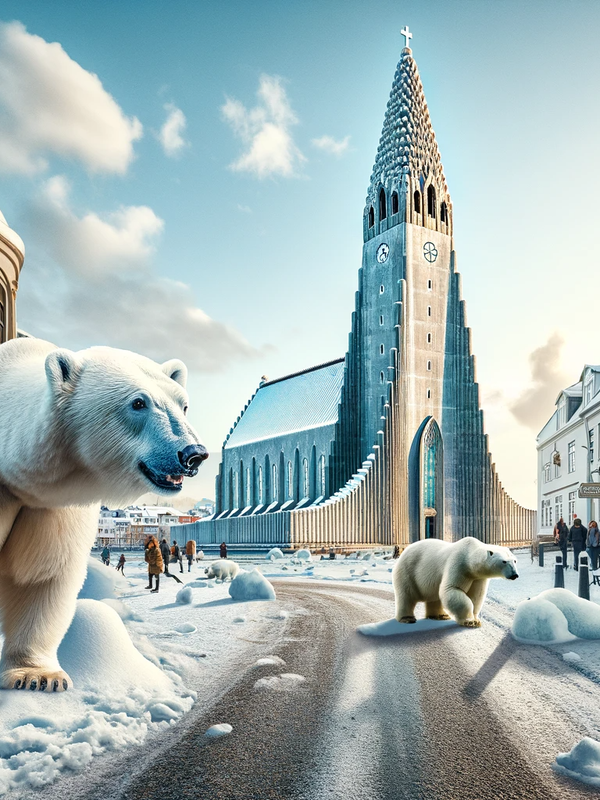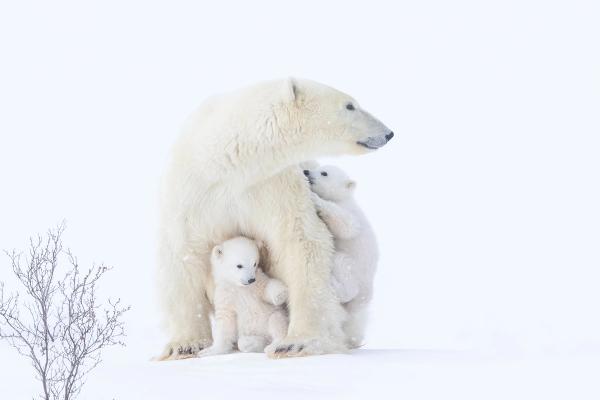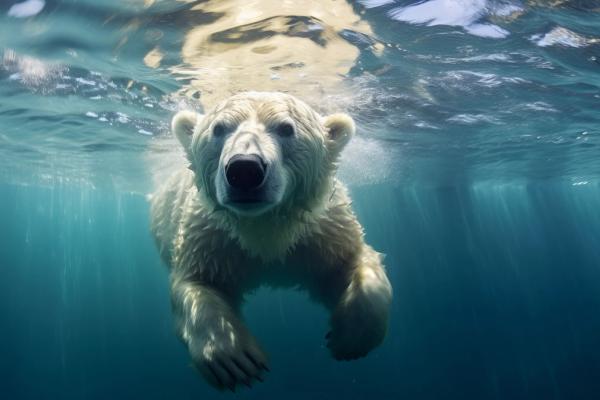
Are There Polar Bears in Iceland?
A majestic creature of the North, the polar bear is often associated with the icy landscapes of the Arctic Circle, not the volcanic terrain of Iceland. Yet, these marine mammals have been making sporadic appearances on Icelandic shores, sparking a flurry of interest and concern. But why “are there polar bears in Iceland”, native to the Arctic, being sighted in Iceland? Let’s delve into this intriguing mystery.
Key Takeaways
- Polar bears are not native to Iceland but have been sporadically sighted due to climate change and drifting ice.
- International cooperation is essential for the conservation of polar bears, with sustainable tourism practices playing an important role in their preservation.
- Iceland also has a diverse range of wildlife, including puffins, gyrfalcons, Arctic foxes, and whales; some species populations have decreased significantly due to environmental impacts.
The Polar Bear Situation in Iceland
To comprehend the presence of polar bears in Iceland, we must first establish that these creatures are not native to this country. In fact, the island’s environment isn’t suitable for these maritime mammals. The absence of year-round Arctic sea ice and the limited diversity of prey in Iceland’s marine ecosystem make it inhospitable for polar bears.
Yet, sightings of polar bears in Iceland do occur, but only under certain environmental circumstances. Occasionally, some of these majestic beasts might be spotted in the country, but such occurrences are rare. There is no permanent population of polar bears in Iceland, and these sightings often raise questions about climate change and its impact on the natural habitats of these Arctic dwellers.
Given the unsuitability of the environment, one might wonder why polar bears are sighted in Iceland. The answer lies in a combination of factors, predominantly related to climate change and drifting ice. These forces sometimes compel polar bears to travel vast distances, occasionally leading them to Iceland. However, the sporadic nature of these visits and the hardships faced by polar bears in Iceland make it unlikely for a permanent population to thrive here.

Historical Sightings of Polar Bears in Iceland
Polar bears have been spotted in Iceland for centuries, with the earliest recorded sighting dating back to 890—just 16 years after the first settlers arrived. Since then, around 600 sightings have been documented, though some estimates put the number closer to 700. These bears usually reach Iceland from Greenland, drifting over on sea ice. However, sightings are rare, averaging about one every two years since 1951.
The most recent confirmed sighting was in September 2024, the first since 2016. While the number of sightings has fluctuated over time, climate change and shifting sea ice conditions may have contributed to recent increases. It’s also possible that some encounters go unreported, so the actual number could be higher.
Climate Change and Polar Bears
The rising number of polar bear sightings in Iceland is largely due to climate change. Polar bears are the only bear species found in the Arctic, and they are directly affected by climate change. This has led to the melting of polar ice caps and a significant reduction in their natural habitat.
With escalating temperatures and shrinking sea ice, polar bears are facing increased challenges. Hunting their primary prey, seals, has become more difficult, leading to longer fasting periods. Consequently, polar bears are forced to seek alternative food sources, sometimes resorting to scavenging for waste or searching for food on land. This quest for sustenance is why we occasionally find polar bears venturing as far as Iceland.
Polar Bear Migration to Iceland
The intriguing question is, how do polar bears, which are not native to Iceland, end up here? The answer lies in their migration patterns, which are influenced by environmental factors. Polar bears reach Iceland due to melting ice and shifting patterns, which cause them to drift on ice or swim in search of new territories and food.
Bears can find their way to Iceland from Greenland on icebergs or by swimming long distances. This polar bear's travel journey is a rare occurrence. It’s worth noting that polar bears are adept swimmers and can traverse distances of up to 100 kilometers in approximately 11 hours. They can even swim continuously for a week without pausing to reach destinations such as Iceland. However, it is challenging to estimate how many polar bears reach Iceland, as sightings are rare and sporadic.
Drifting Ice and Icebergs
Polar bears reach Iceland by drifting on ice floes or icebergs. The phenomenon of ice floe drift in the Arctic is affected by various factors, including wind, ocean currents, and temperature gradients. Fluctuations in weather patterns due to climate change can impact ice drift by modifying wind patterns and ocean currents and inducing melting and fragmentation of the ice.
The movement of ice floes and icebergs is notably affected by climate change. Rising temperatures result in the melting of sea ice and diminish its capacity to reflect sunlight, thereby causing additional warming. The accelerated melting of glaciers in regions such as Greenland also plays a role in the movement of ice masses due to the warming climate. As a result, polar bears find themselves on ice floes drifting towards Iceland, particularly during the spring months.
Swimming Abilities of Polar Bears
Polar bears are not just skilled at drifting on ice; they are also excellent swimmers. Two polar bears, for instance, have sizable, webbed paws that function as efficient paddles for propelling through water. Their hollow fur contributes to buoyancy, enabling them to float and navigate cold waters adeptly.
These bears exhibit remarkable endurance when it comes to swimming. They are capable of swimming continuously for an extended period, covering great distances. There is a documented record of a polar bear swimming for nine days straight, spanning a distance of 426 miles (687 kilometers). Their typical swimming velocity is around 6.2 mph (10 kph).

Encountering Polar Bears in Iceland
While it’s rare to encounter a polar bear in Iceland, it isn’t beyond the realms of possibility. Despite the slim chances, awareness of safety measures for potential encounters is vital.
If you come across a polar bear, follow these guidelines:
- Remain composed and assess the situation.
- Appear larger by raising your arms or holding objects above your head.
- Refrain from approaching the bear.
- If feasible, gather in a group.
- Avoid sudden movements.
- Avoid making eye contact.
These practices can help ensure your safety when encountering a polar bear, including a female polar bear.
Staying Safe Around Polar Bears
If you happen to encounter a polar bear, the first order of business is to remain calm. Making yourself appear larger, avoiding approaching the bear, and grouping together if possible are recommended behaviors. If you can’t leave the area immediately, it’s suggested to protect your head, neck, and core, and use any available objects to hit the bear in the face, aiming for the nose or eyes.
Tourists can also take certain precautions to prevent encounters with polar bears. Here are some measures to consider:
- Refrain from camping in regions with active glaciers, pack ice, or documented polar bear activity.
- Stay in designated campgrounds or in proximity to farms, as these areas are considered safer.
- If a polar bear is sighted, maintain a safe distance and promptly vacate the area.
Reporting Polar Bear Sightings
Speedy reporting of any polar bear sightings in Iceland to local authorities is of utmost importance. This helps safeguard the well-being of both humans and the animal. You can contact the local authorities, such as the police or the coast guard, to report the sighting.
When reporting a polar bear sighting, try to include specific details like:
- The location
- The date and time
- A description of the bear’s behavior
- Any accompanying photos or videos
While waiting for authorities to arrive, prioritize safety. If possible, leave the area or take an alternative route. If leaving is not feasible, wait for the bear to move away and ensure it has an escape route. It’s important not to run and to remain composed. Stay informed about local news for any developments regarding polar bear sightings.
Polar Bear Conservation Efforts
The increasing frequency of polar bear sightings in Iceland draws attention to the broader issue of conserving these creatures. Protecting polar bear habitats and populations requires comprehensive efforts, ranging from international cooperation to responsible tourism practices.
Addressing climate change is a key aspect of these conservation efforts. The loss of Arctic sea ice due to rising global temperatures poses a significant threat to polar bears. Oil spills have profound impacts on polar bears. It can damage their fur’s insulating properties, expose them to toxic chemicals and potentially lead to poisoning..
The tourism industry also plays a crucial role in polar bear conservation. By promoting sustainable tourism practices and raising awareness about the importance of protecting polar bear habitats, the industry can contribute significantly to conservation efforts.

International Cooperation
Polar bear conservation is a global effort, requiring international cooperation. The 1973 Agreement on the Conservation of Polar Bears is a key international legal measure established to safeguard polar bears. Endorsed by the five nations with the most substantial polar bear populations, it prohibits unregulated sport hunting of polar bears as well as hunting from aircraft and large motorized vessels.
The Paris Agreement is another significant piece of international legislation. This treaty aims to combat climate change and has implications for polar bear habitats by aiming to limit global temperature rise and reduce greenhouse gas emissions.
The Arctic Council, operating within the Arctic Circle, also plays a crucial role in polar bear conservation through the monitoring of populations and the implementation of standard assessment measures.
Role of Tourism Industry
The tourism industry in Iceland plays a significant role in polar bear conservation. By promoting sustainable tourism practices, educating tourists, and advocating for responsible tourism, the industry contributes to the preservation of polar bears.
Significant donations made by both passengers and operators to environmental and conservation organizations play a crucial role in funding the maintenance, protection, and monitoring of the polar bear habitat. Examples of responsible wildlife encounter programs include:
- Responsible whale watching tours
- Volunteer programs for land-based observations of whales and other marine animals
- Tour operators that prioritize responsible tourism
These programs help ensure that wildlife encounters are conducted in a responsible and sustainable manner.
Summary
In conclusion, while polar bears are not native to Iceland, changes in climate and environmental conditions have led to increased sightings. These majestic creatures often arrive in Iceland due to drifting ice floes or swimming long distances from Greenland. However, the harsh environment and lack of suitable habitat make it difficult for a permanent polar bear population to establish in Iceland.
Despite the challenges, there are ongoing efforts to protect these magnificent creatures. From international cooperative agreements to responsible tourism practices, various initiatives are in place to conserve polar bears and their habitats. As individuals, we can contribute by staying informed, respecting wildlife, and supporting conservation efforts. After all, the future of polar bears is in our hands.
